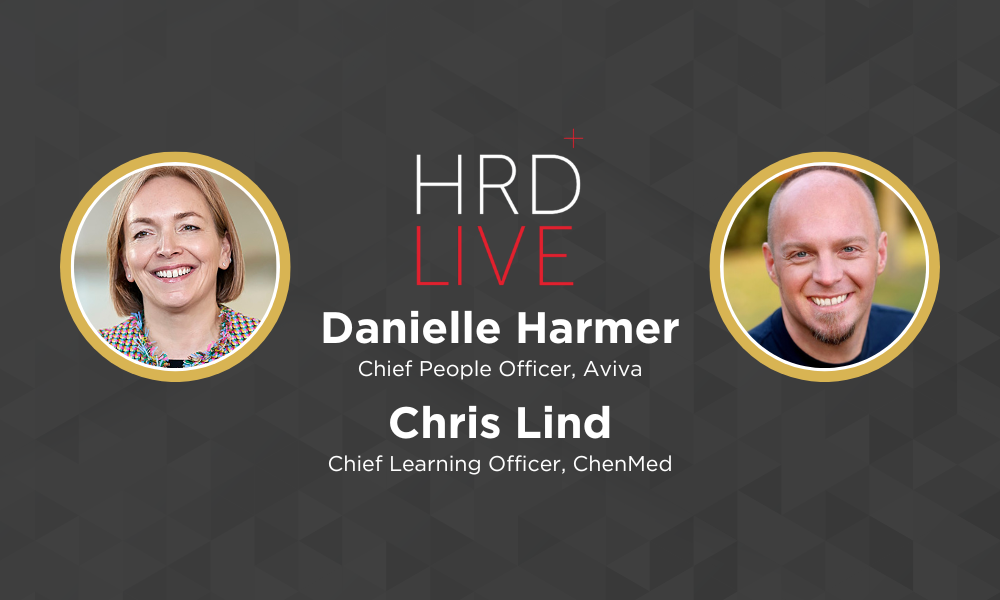AI and People: How HR can lead digital transformation through participative upskilling
- 5 Min Read
Danielle Harmer, Chief People Officer, Aviva, and Chris Lind, Chief Learning Officer, ChenMed, join the HRD Live podcast to examine the relationship between AI and People. They share insights on how HR leaders can best navigate digital transformation through upskilling, including anecdotes from their own organizations, to ensure a human-centric adoption of AI that delivers the best business outcomes.
- Author: Benjamin Broomfield
- Date published: Aug 16, 2023
- Categories

Podcast: Play in new window | Download Subscribe: RSS
Are HR and People leaders the guardians of the challenges and opportunities presented by AI in the workplace? The answer, according to Danielle Harmer, Chief People Officer, Aviva, and Chris Lind, Chief Learning Officer, ChenMed, is yes. The inherent connection between AI and people mandates HR leaders to support, develop, and upskill their colleagues.
Harmer and Lind are the latest HRD Live podcast guests for the Future of Work series and agree that HR’s responsibility is to consider and nurture the skills of its future workforce, including AI capabilities. In this episode, we cover how and why organizations can drive the best business outcomes through AI by carefully supporting their people through upskilling and clear communication.
The inherent AI and people connection and why it matters
“People create technology,” begins Harmer. “People lead the people… …you need people with the skills to build digital journeys for customers or colleagues.”
Lind echoes this sentiment: “Even with large language models… …it’s all built with people. People were the ones behind it.” Both leaders are acknowledging that all too often, organizations portray AI as ‘fairy dust’ that overpromises when people are not given the skills they need to work alongside the technology.
Neglecting the relationship between AI and People and the implications this has for skills development constrains the impact of AI on business outcomes; or, as Harmer describes it, “a chatbot circular hell.”
This reality is already facing organizations that have rushed into AI implementation without taking the necessary time to plan what it means for their people. Lind, taking an optimistic view, sees this as an opportunity for HR: “There is an opportunity, if we’re as familiar with the technology as we possibly can be, to be almost trilingual…being able to speak the business language and technology language, but then also bringing the human experience lens to it.”
AI and people: Upskilling in practice
Aviva is already seeing the benefits of a people-centric and considered approach to AI implementation. Its learning community, ‘The Aviva Foundry,’ is designed to equip employees with the skills they need to thrive in a digital world of work. “There is no magic cupboard somewhere of people with digital skills,” explains Harmer. “You need to equip them with some of the technical skills. And so, we set up the Foundry to do that.”
In July 2023, the first graduate of The Aviva Foundry, formerly in the customer experience team, became a software engineer. “It’s her dream job, and it’s what she always wanted to do,” adds Harmer. Moreover, this employee is now solving business-critical technical problems.
Harmer’s story emphasizes the importance of the human side to AI implementation. Lind draws on the story, and his own experience within healthcare: “There’s an emotional side of this to help people understand. We didn’t hire you to do these tasks. That’s not what you bring to the table. But let us help you see beyond the tasks.”
Focusing on the connection between AI and people, and taking a human-centric approach to reskilling, is critical. “We’re dealing with people, and people aren’t robots. We can’t just deprogram them and reprogram them to do something else,” explains Lind.
Why communication matters during AI transformation
Harmer goes on to highlight the need for organizations and HR teams to be realistic and reassuring during times of change and digital transformation. “We’re focusing heavily at Aviva on saying, ‘We’ve got the people we need; we know where jobs are heading.’ All we need to do is give the skills to our people.”
Aviva begins this process by developing a thorough skills architecture to compare technical and non-technical roles and assess the similarity and transferability of skills. The people team then positions itself to communicate exactly how it is prepared to invest in its people’s development.
Lind agrees that this approach is the most beneficial to an organization and its people. “Have some of those open and honest conversations with your employees,” he says. “Bring them along for a ride and give them a choice.” Trusting employees and inviting them into the conversation about skills adjacencies ensures those who take part in upskilling and reskilling are not just able, but also willing.
Tune into the full HRD Live episode to hear Harmer and Lind discuss the importance of workforce planning and break down further examples from Aviva and ChenMed about the connection between AI and People.
Timestamps
00:09 – Introduction
01:16 – Are HR leaders the guardians in navigating the challenges and opportunities presented by technologies such as AI?
08:00 – Danny, Aviva has made lots of progress by introducing learning academies and data fluency programs – can you share more about the progress you have made?
09:48 – Chris, how would you describe the journey that you’ve been on with upskilling and preparing employees for a future where hopefully they’re using AI?
18:29 – How do we get people to a point where they’re excited, rather than anxious, about AI?
_______________
Danielle is Chief People Officer at Aviva, leading its global People and Culture strategy. She is passionate about supporting its people and keeping things simple. Before joining Aviva, Danny was the Chief People Officer at Metro Bank for over seven years and previously held a variety of roles in HR and business leadership at Halifax, HBOS, Lloyds Banking Group, and Barclays. She was recognized as one of HR Magazine’s ‘Most Influential Practitioners’ from 2016-2022.
Chris Lind is Chief Learning Officer at ChenMed. He is a globally recognized, digital-first leader in learning and workplace technology, living at the intersection of business, technology, and the human experience. He is the author of Relentless Intention and host of Learning Tech Talks.








